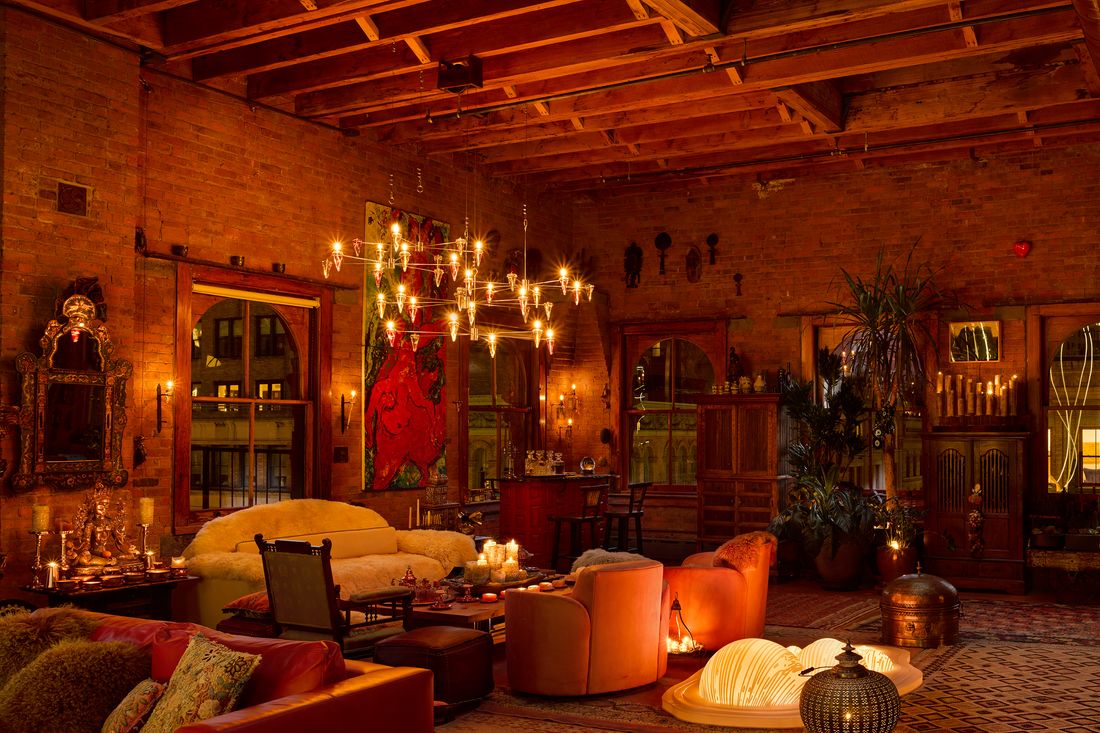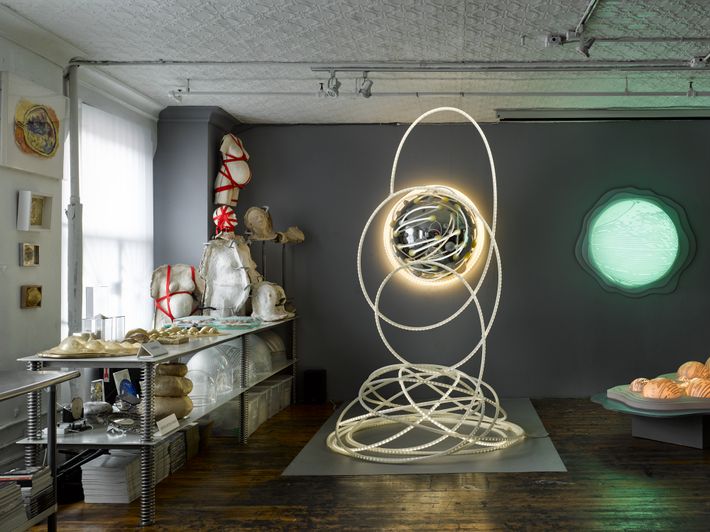
The first time I visited the loft Grimanesa Amorós shares with her husband, William Grant Fleischer, and daughter Shammiel, it was on the occasion of a dinner party. The vast living room atop a wonderful old Tribeca building was lit only by candles and Amorós’s light sculptures, which rest on the floor or float through the air the way jellyfish do through water, pulsing in different colors and appearing to shift shapes.
Amorós was born and raised in Lima, Peru, and the loft is populated with a mix of art and furnishings from her childhood and later travels: rugs from India and Morocco, a coffee table from Indonesia, a bird boat from Myanmar, 17th- and 18th-century lanterns and wooden chests. No two sofas are alike, and during the party, guests drifted among islands of gathering places centered beneath candelabras — many from Peru — or sat around the fireplace or at the wooden table. At one end of the room is a centuries-old convent door. To the side of that, hanging from a ceiling beam by the kitchen, is an indoor swing that Amorós made from a piece of wood.
The loft itself has a history that had to be revealed. “The brick walls were covered with thick layers of plaster and many coats of paint, and the floor was covered in cement,” Amorós recalls. “People were in here with jackhammers for ten days because there was so much. The wood underneath was very well protected by black paper and tar and more paper.” The tin ceiling, in disrepair, was removed to reveal the wooden beams.
During a midmorning visit, the room takes on a different character. “This settee was bloodred,” Amorós says, “and it turned salmon from the sun,” which comes in through the skylights. The same is true for the colors of all the rugs on the living-room floor; she takes a corner of one in her fingers and flips it over to reveal a more intense color. “Once upon a time, they were like that, but that is the beauty also,” she says. “Everything changes in this house. I like to use it.”
Change and the love of adventure have been constants in Amorós’s life. She came to America from Peru in 1984. “I got a ticket one way, I grabbed two bags, and I left for New York,” she says. Her father had encouraged her to study to become a psychologist, but she left university three months before graduation: “I knew I was never going to use that degree. I also knew I would never be starving because I know how to draw, so I could always sit on the street and do portraits.” In New York, she studied at the Art Students League from 1985 to 1988.
After many shared studios on the Bowery, Amorós met Fleischer, and they married on a boat near the Statue of Liberty in 1988. They lived briefly in Forest Hills, then found space in their current building. Amorós initially attempted to add a studio inside the living space. Soon, she says, she found “it wasn’t a good idea. I was too distracted.” She discovered a separate studio in the building in 1993, and they moved into the duplex apartment around 2009, before the renovation was complete.
Amorós turned from painting and sculpture to creating light installations after seeing the northern lights during a trip to Iceland in 2001. But her childhood in Lima and all the natural wonders around her are what have always captivated her imagination and remain most relevant to her work today, like the patterns and iridescence of the sea-foam along the shore. She also made a practice of drawing and memorizing maps of various countries. Her sculptures today bring forward the ephemeral mystery of light using LED and 3-D technology.
Her work has been exhibited around the world, from Times Square to the Venice Biennale to the Noor Riyadh festival of light and art in Saudi Arabia. “I always compare my life to how a river moves,” she explains. “Water cannot be stopped; it will always find a little hole to make it to the other side. So I always have that metaphorical way of seeing my life — that it always keeps going.”
More Great Rooms
- Just Follow the Red Door Through the Trees
- A Jubliantly Traditional Carnegie Hill Classic Six
- Object & Thing Goes to the Beach










